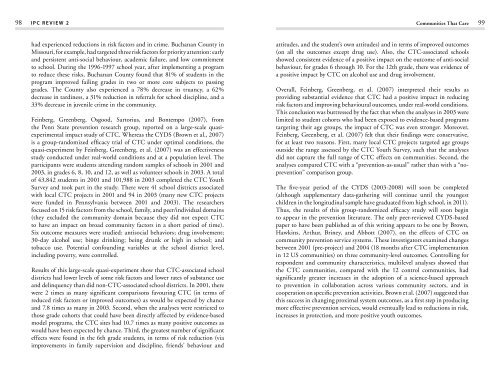Revue de L' R e v I e W - Faculty of Social Sciences - Université d ...
Revue de L' R e v I e W - Faculty of Social Sciences - Université d ...
Revue de L' R e v I e W - Faculty of Social Sciences - Université d ...
Create successful ePaper yourself
Turn your PDF publications into a flip-book with our unique Google optimized e-Paper software.
98 I P C R e v i e w 2 Communities That Care 99<br />
had experienced reductions in risk factors and in crime. Buchanan County in<br />
Missouri, for example, had targeted three risk factors for priority attention: early<br />
and persistent anti-social behaviour, aca<strong>de</strong>mic failure, and low commitment<br />
to school. During the 1996-1997 school year, after implementing a program<br />
to reduce these risks, Buchanan County found that 81% <strong>of</strong> stu<strong>de</strong>nts in the<br />
program improved failing gra<strong>de</strong>s in two or more core subjects to passing<br />
gra<strong>de</strong>s. The County also experienced a 78% <strong>de</strong>crease in truancy, a 62%<br />
<strong>de</strong>crease in tardiness, a 31% reduction in referrals for school discipline, and a<br />
33% <strong>de</strong>crease in juvenile crime in the community.<br />
Feinberg, Greenberg, Osgood, Sartorius, and Bontempo (2007), from<br />
the Penn State prevention research group, reported on a large-scale quasiexperimental<br />
impact study <strong>of</strong> CTC. Whereas the CYDS (Brown et al., 2007)<br />
is a group-randomized efficacy trial <strong>of</strong> CTC un<strong>de</strong>r optimal conditions, the<br />
quasi-experiment by Feinberg, Greenberg, et al. (2007) was an effectiveness<br />
study conducted un<strong>de</strong>r real-world conditions and at a population level. The<br />
participants were stu<strong>de</strong>nts attending random samples <strong>of</strong> schools in 2001 and<br />
2003, in gra<strong>de</strong>s 6, 8, 10, and 12, as well as volunteer schools in 2003. A total<br />
<strong>of</strong> 43,842 stu<strong>de</strong>nts in 2001 and 101,988 in 2003 completed the CTC Youth<br />
Survey and took part in the study. There were 41 school districts associated<br />
with local CTC projects in 2001 and 94 in 2003 (many new CTC projects<br />
were fun<strong>de</strong>d in Pennsylvania between 2001 and 2003). The researchers<br />
focused on 15 risk factors from the school, family, and peer/individual domains<br />
(they exclu<strong>de</strong>d the community domain because they did not expect CTC<br />
to have an impact on broad community factors in a short period <strong>of</strong> time).<br />
Six outcome measures were studied: antisocial behaviors; drug involvement; .<br />
30-day alcohol use; binge drinking; being drunk or high in school; and<br />
tobacco use. Potential confounding variables at the school district level,<br />
including poverty, were controlled.<br />
Results <strong>of</strong> this large-scale quasi-experiment show that CTC-associated school<br />
districts had lower levels <strong>of</strong> some risk factors and lower rates <strong>of</strong> substance use<br />
and <strong>de</strong>linquency than did non-CTC-associated school districts. In 2001, there<br />
were 2 times as many significant comparisons favouring CTC (in terms <strong>of</strong><br />
reduced risk factors or improved outcomes) as would be expected by chance<br />
and 7.8 times as many in 2003. Second, when the analyses were restricted to<br />
those gra<strong>de</strong> cohorts that could have been directly affected by evi<strong>de</strong>nce-based<br />
mo<strong>de</strong>l programs, the CTC sites had 10.7 times as many positive outcomes as<br />
would have been expected by chance. Third, the greatest number <strong>of</strong> significant<br />
effects were found in the 6th gra<strong>de</strong> stu<strong>de</strong>nts, in terms <strong>of</strong> risk reduction (via<br />
improvements in family supervision and discipline, friends’ behaviour and<br />
attitu<strong>de</strong>s, and the stu<strong>de</strong>nt’s own attitu<strong>de</strong>s) and in terms <strong>of</strong> improved outcomes<br />
(on all the outcomes except drug use). Also, the CTC-associated schools<br />
showed consistent evi<strong>de</strong>nce <strong>of</strong> a positive impact on the outcome <strong>of</strong> anti-social<br />
behaviour, for gra<strong>de</strong>s 6 through 10. For the 12th gra<strong>de</strong>, there was evi<strong>de</strong>nce <strong>of</strong><br />
a positive impact by CTC on alcohol use and drug involvement.<br />
Overall, Feinberg, Greenberg, et al. (2007) interpreted their results as<br />
providing substantial evi<strong>de</strong>nce that CTC had a positive impact in reducing<br />
risk factors and improving behavioural outcomes, un<strong>de</strong>r real-world conditions.<br />
This conclusion was buttressed by the fact that when the analyses in 2003 were<br />
limited to stu<strong>de</strong>nt cohorts who had been exposed to evi<strong>de</strong>nce-based programs<br />
targeting their age groups, the impact <strong>of</strong> CTC was even stronger. Moreover,<br />
Feinberg, Greenberg, et al. (2007) felt that their findings were conservative,<br />
for at least two reasons. First, many local CTC projects targeted age groups<br />
outsi<strong>de</strong> the range assessed by the CTC Youth Survey, such that the analyses<br />
did not capture the full range <strong>of</strong> CTC effects on communities. Second, the<br />
analyses compared CTC with a “prevention-as-usual” rather than with a “noprevention”<br />
comparison group.<br />
The five-year period <strong>of</strong> the CYDS (2003-2008) will soon be completed<br />
(although supplementary data-gathering will continue until the youngest<br />
children in the longitudinal sample have graduated from high school, in 2011).<br />
Thus, the results <strong>of</strong> this group-randomized efficacy study will soon begin<br />
to appear in the prevention literature. The only peer-reviewed CYDS-based<br />
paper to have been published as <strong>of</strong> this writing appears to be one by Brown,<br />
Hawkins, Arthur, Briney, and Abbott (2007), on the effects <strong>of</strong> CTC on<br />
community prevention service systems. These investigators examined changes<br />
between 2001 (pre-project) and 2004 (18 months after CTC implementation<br />
in 12 US communities) on three community-level outcomes. Controlling for<br />
respon<strong>de</strong>nt and community characteristics, multilevel analyses showed that<br />
the CTC communities, compared with the 12 control communities, had<br />
significantly greater increases in the adoption <strong>of</strong> a science-based approach<br />
to prevention in collaboration across various community sectors, and in<br />
cooperation on specific prevention activities. Brown et al. (2007) suggested that<br />
this success in changing proximal system outcomes, as a first step in producing<br />
more effective prevention services, would eventually lead to reductions in risk,<br />
increases in protection, and more positive youth outcomes.

















